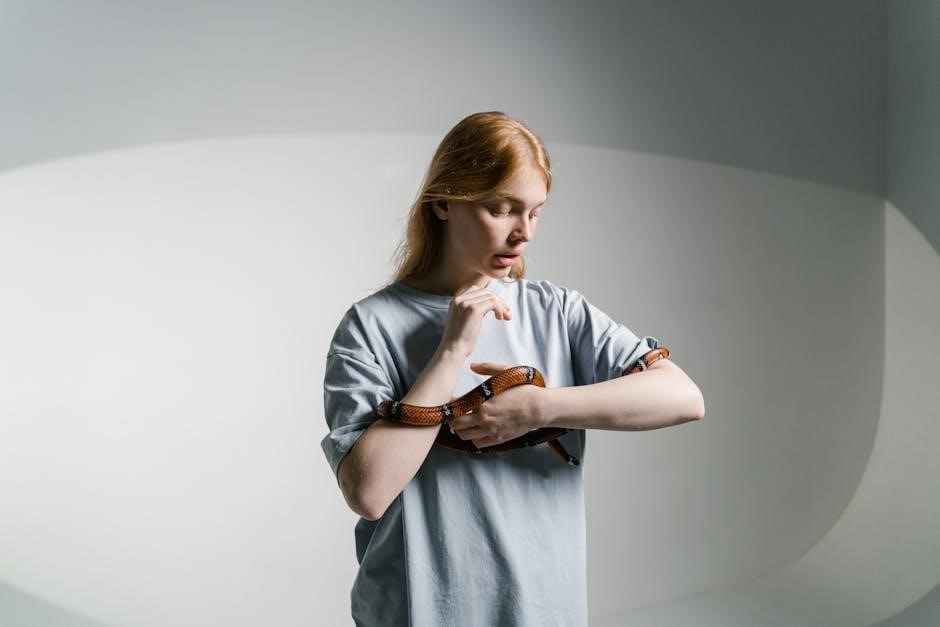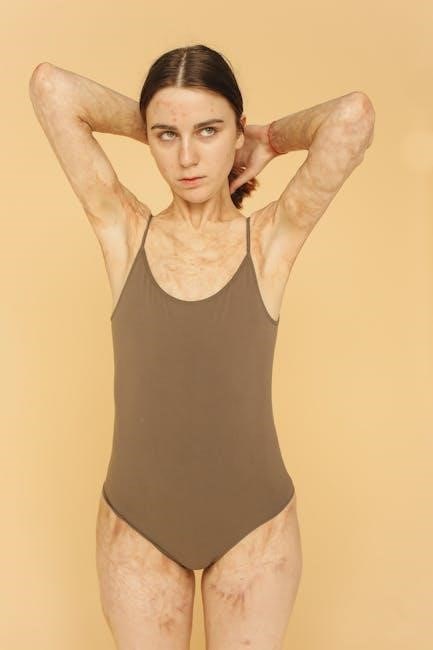Internalized homophobia refers to the absorption of societal homophobic attitudes, leading to self-shame and emotional distress. This guide explores its roots, emotional impact, and strategies for healing and self-acceptance.
1.1 Defining Internalized Homophobia
Internalized homophobia is a psychological state where individuals unconsciously adopt and internalize homophobic attitudes, often leading to self-loathing and discomfort with their sexual orientation. This phenomenon arises when societal prejudices and negative stereotypes are deeply ingrained, causing individuals to view themselves through a lens of shame and inadequacy. It manifests as self-rejection, denial, or even hatred toward one’s identity, creating a divide between their true self and the persona they feel compelled to present to the world. Understanding this concept is crucial for addressing its profound emotional and psychological effects.
1.2 The Impact of Societal Norms on Self-Perception
Societal norms, especially heteronormativity and traditional gender roles, significantly influence self-perception. Internalizing these expectations often leads to self-judgment and alienation from one’s true identity. The pressure to conform can cause emotional distress and self-rejection, creating a barrier to self-acceptance and genuine expression, complicating the journey toward healing and self-compassion.

Understanding the Causes of Internalized Homophobia
Internalized homophobia stems from external factors like upbringing, environment, and societal messages. These influences shape self-view, often leading to self-rejection and emotional conflict, rooted in early life experiences.
2.1 The Role of Upbringing and Environment
Upbringing and environment significantly shape internalized homophobia. Growing in strict, heteronormative households or communities often instills shame and rejection of one’s identity. Family, religion, and societal norms can perpetuate negative beliefs, leading to self-conflict and internalized prejudice. Early exposure to homophobic language or behaviors reinforces feelings of inadequacy. This environment fosters a disconnect between one’s true self and societal expectations, deeply embedding self-hatred and fear of rejection. These foundational experiences often require concerted effort to unpack and overcome in the journey toward self-acceptance.
2.2 The Influence of Media and Representation
Media and representation play a crucial role in shaping perceptions of sexuality. Negative stereotypes, lack of diverse portrayals, and outright invisibility in media can perpetuate internalized homophobia. When LGBTQ+ individuals are depicted as flawed, immoral, or marginal, it reinforces harmful beliefs. Conversely, positive representation can challenge these narratives, fostering acceptance. The absence of relatable role models often leaves individuals feeling disconnected and ashamed, further internalizing societal prejudice. This lack of authentic representation exacerbates feelings of inadequacy and self-doubt, making it harder to embrace one’s true identity.
2.3 The Effects of Trauma and Discrimination
Trauma and discrimination profoundly contribute to internalized homophobia. Experiences of bullying, rejection, or violence can instill deep-seated shame and self-hatred. Discrimination reinforces feelings of unworthiness, often leading to self-blame for being LGBTQ+. These traumatic events, compounded by societal prejudice, create a cycle of negative self-perception. The emotional toll can manifest as anxiety, depression, or self-destructive behaviors. Such experiences make it difficult to reconcile one’s identity with societal expectations, further internalizing homophobic beliefs and perpetuating a painful cycle of self-doubt and alienation.

Recognizing the Emotional and Psychological Toll
Internalized homophobia often manifests as deep-seated shame, anxiety, and self-doubt, significantly impacting mental health, self-esteem, and emotional well-being, fostering feelings of inadequacy and low self-worth.
3.1 The Cycle of Shame and Self-Hatred
Internalized homophobia often creates aicious cycle of shame and self-hatred, where individuals internalize societal homophobic messages, leading to self-loathing and self-rejection. This cycle reinforces feelings of worthlessness and guilt, perpetuating emotional pain and mental health struggles. Shame can manifest as anxiety, depression, or self-destructive behaviors, further isolating individuals and preventing them from seeking help or forming healthy relationships. Breaking this cycle requires acknowledging its roots and actively challenging harmful beliefs, which is a critical step toward healing and self-acceptance.
3.2 The Struggle with Self-Esteem and Identity
Internalized homophobia often erodes self-esteem, as individuals grapple with negative societal perceptions of their sexuality. This can lead to confusion, self-doubt, and a fractured sense of identity. Many struggle to reconcile their sexual orientation with their self-worth, feeling unworthy of love and acceptance. This inner conflict can hinder personal growth and relationships, as shame and self-criticism dominate their self-image. Acknowledging and addressing these struggles is essential for rebuilding self-esteem and embracing a authentic, whole identity.
3.3 The Fear of Rejection and Isolation
Internalized homophobia often fosters a deep-seated fear of rejection, as individuals anticipate judgment from others due to their sexual orientation. This fear can lead to social withdrawal and isolation, as they may avoid forming intimate connections or expressing their true selves. The constant anxiety of being rejected by family, friends, or society creates emotional barriers, further complicating the journey toward self-acceptance. This isolation can exacerbate feelings of loneliness and disconnection, making it harder to heal and embrace one’s identity.

The Journey Toward Self-Acceptance
Overcoming internalized homophobia involves a transformative journey of self-discovery, unlearning harmful beliefs, and embracing authenticity. It requires patience, courage, and a willingness to heal and grow.
4.1 Acknowledging and Confronting Shame
Acknowledging shame is the first step toward healing from internalized homophobia. It involves recognizing the deeply ingrained beliefs and feelings of inadequacy without judgment. Confronting shame requires self-compassion and understanding its roots in societal and personal experiences. Through self-reflection or therapy, individuals can identify and challenge these harmful narratives, gradually replacing them with affirming and empowering beliefs. This process fosters emotional liberation and paves the way for authentic self-acceptance. It is a courageous and essential step in overcoming internalized homophobia and reclaiming one’s identity with dignity and pride.
4.2 Challenging Negative Beliefs and Thought Patterns
Challenging negative beliefs is crucial in overcoming internalized homophobia. This involves identifying and questioning harmful thought patterns rooted in societal bias or past experiences. Cognitive techniques, such as reframing negative thoughts, can help replace self-criticism with self-compassion. Self-reflection and therapy are powerful tools to uncover and dismantle these beliefs, fostering a more authentic and positive self-image. By actively confronting and redefining these narratives, individuals can break free from internalized shame and cultivate a healthier, more affirming mindset. This process requires patience and consistent effort to transform deeply ingrained beliefs.
4.3 Embracing Self-Compassion and Empathy
Embracing self-compassion and empathy is a vital step in healing from internalized homophobia. Practicing self-kindness involves treating oneself with the same care and understanding offered to others. Mindfulness and journaling can help individuals reconnect with their emotions, fostering a sense of gentleness and acceptance. Empathy toward oneself and others reduces self-judgment and promotes unity within the LGBTQ+ community. By cultivating compassion, individuals can counteract harmful self-perceptions and build a foundation of self-worth, leading to greater emotional resilience and authenticity in their journey toward acceptance.

Seeking Support and Building a Supportive Network
Building a supportive network is crucial for healing. Surrounding oneself with understanding friends, family, and communities fosters safety and acceptance, aiding in the journey toward self-acceptance and resilience.
5.1 The Importance of Therapy and Counseling
Therapy and counseling provide a safe space to explore and address internalized homophobia. Trained professionals can help individuals identify harmful beliefs, challenge negative thought patterns, and develop healthier self-perceptions. Through techniques like cognitive-behavioral therapy or trauma-informed approaches, therapy fosters self-compassion and resilience. A therapist can also serve as a guide, offering tools to navigate societal pressures and internalized shame. Engaging in therapy is a courageous step toward healing, allowing individuals to reclaim their authenticity and build a more loving relationship with themselves.
5.2 Finding Community and Connection
Building a supportive community is crucial for healing from internalized homophobia. Surrounding oneself with understanding individuals fosters a sense of belonging and validation, reducing feelings of isolation. Support groups, both online and in-person, provide safe spaces for open dialogue and shared experiences. Connecting with others who understand the journey can empower individuals to embrace their authentic selves and move beyond self-hatred. Community connection not only offers emotional support but also reinforces self-acceptance and resilience, playing a vital role in the healing process.
5.3 The Role of Allies in the Healing Process
Allies play a vital role in the healing journey by offering unconditional support and validation. Their presence helps counteract feelings of isolation and rejection, fostering a sense of safety and acceptance. Allies can amplify LGBTQ+ voices, challenge harmful stereotypes, and advocate for inclusive environments. By actively listening and educating themselves, allies help individuals rebuild self-worth and combat internalized homophobia. Their unwavering support and commitment to equality create a foundation for healing, empowerment, and resilience.
Overcoming internalized homophobia is a journey of courage and self-discovery. By acknowledging pain, challenging harmful beliefs, and embracing self-compassion, individuals can heal and reclaim their authenticity. Surrounding oneself with supportive allies and communities fosters resilience and hope. Remember, healing is not linear but a process of growth. Embracing one’s true self is a powerful act of defiance against societal norms. With time, patience, and support, it’s possible to move beyond shame and live a life filled with pride, love, and self-acceptance.



